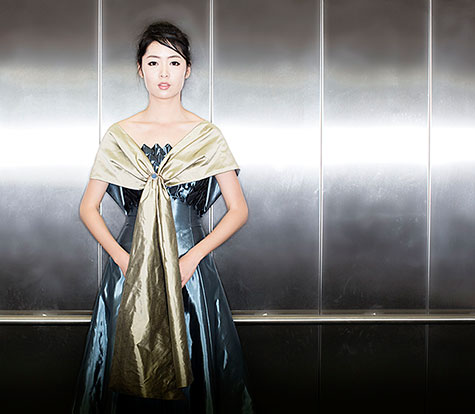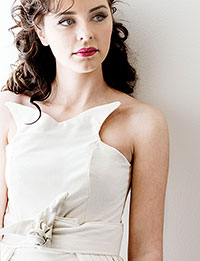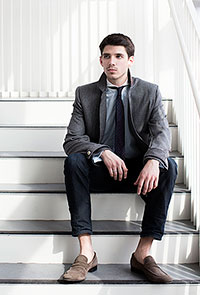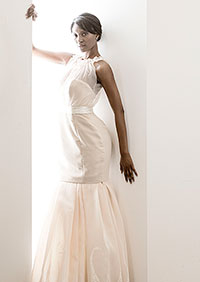
The more you know about something, the more complicated it becomes.
Fashion design is both a singular practice and a series of interrelated skills. Inspiration leads to sketching, which leads to pattern-making, tailoring and construction, which in turn mark the pathway from studio to catwalk to retail environment.

But for Washington University fashion design majors, the puzzle pieces all come together at 6 p.m. Sunday, May 5, when the Sam Fox School of Design & Visual Arts presents its 84th Annual Fashion Design Show.
Featuring dozens of models wearing scores of outfits created by 26 aspiring designers, this New York runway-style extravaganza will take place in the Ballroom Theater of WUSTL’s 560 Music Center.
Tickets are $65 for general seating, or $50 for students, and are available through the Edison Theatre Box Office, (314) 935-6543, and all MetroTix outlets.
Discounted tickets, of $45 and $35, are available prior to May 1. Special reserved seats, with higher prices going to fund scholarships in the program, are also available.
For more information, email samfoxschool@wustl.edu.
The complete look
“Putting something out on the runway, you learn that it’s all about creating a complete look,” says Jennifer Ingram, the W. H. Smith Visiting Assistant Professor of Fashion, who coordinates the show.
“You might spend hours sewing, but if the pattern isn’t made correctly, or if the garment isn’t pressed right, then it isn’t going to fit,” she adds.
A 2004 alumna, Ingram fondly recalls the lessons imparted by the pressure of public presentation. “It has to be understandable to an audience,” she explains. “You might think something is very feminine, only to find that an audience sees it as hard and edgy.
“But when you finally see your look, something that you’ve made, going down the runway? There is a tremendous sense of accomplishment.”

Dresses, formal wear and undergarments
In a new twist, the show will open with kimonos designed by sophomores — a first for the fashion design program.
(Prior to this year, only juniors and seniors were featured in the show.)
Ingram notes that the kimono is rich in history and creative potential, but also simple to construct. “It’s a versatile garment, but not overwhelmed with technical details,” she says. “There are no zippers, no closures, no pockets. You don’t have to cut armholes.”
Next, the junior class will present color-blocked dresses, followed by tailored separates; pants and shirts; and signature dresses. The seniors, meanwhile, will show separates inspired by Underneath It All, the recent survey of undergarments at the Missouri History Museum.
Also on the bill will be formal wear, with each outfit incorporating both a transformational detail and a custom fabric manipulation. Ilana Moreno, for example, offers a cranberry evening gown that converts into a cocktail dress. Collette LeMaire brings hand-painted fabric to her crème-colored bridal gown.
(All formal looks are currently featured in a special exhibition at Plaza Frontenac, in the north center court, near the entrance to Saks Fifth Avenue.)

What kind of designer do you want to be?
Perhaps the highlight of the show will be the seniors’ signature collections. The fashion equivalent to a graduating thesis, each is a fully coordinated clothing line tailored to a specific audience and based on a specific theme.
“You have to decide what type of designer you want to be,” Ingram explains. “What category will you design for? Who’s your target market? What sort of company would you like to work with?”
Abby Katsev, for example, will present children’s wear inspired by the Eloise book series. Katherine Olvera is creating formal cocktail dresses inspired by origami. Chantal Strasburger will offer day dresses influenced by her research of Southeast Asian textiles.
Other inspirations range from architecture (Ann Bullock) and minimalist design (Brian Lee) to the films of director Zhang Yimou (Sophia Fox-Dichter), a mysterious French circus (Carly Oshima) and the Ruined Polaroids of photographer William Miller (Felicia Podberesky).
“It’s a balance of freedom and restriction,” Ingram says. “You can be creative and think outside the box, but you also have to make sure the garment works for a manufacturer and a clientele.
“The idea is to take the skills learned as sophomores and juniors, and to begin using them strategically.”
Organizers and Co-sponsors
Guest panelists for the 84th Annual Fashion Design Show will be Emily Koplar, designer and owner of Wai Ming; Charlotte Kerr, assistant buyer for Neiman Marcus; and Tania Beasley-Jolly and Doug Moss, marketing director and general manager, respectively, of Saks Fifth Avenue.
Stylists are led by Dominic Bertani of the Dominic Michael Salon, who has done the models’ hair for the past 21 years. Makeup is by students from The Paul Mitchell School. Footwear is provided by Brown Shoe. Lighting, audio and runway tech is by Ironman Sound.
Outstanding student designers receive a variety of scholarships, cash prizes and awards. The Dominic Michael Silver Scissors Designer of the Year Award is presented to one outstanding senior at the end of the evening. Susan Sanders Block sponsors the Silver Ripper Award, presented to one outstanding junior. Moss and Beasley-Jolly will present the Saks Fifth Avenue Honorary Designer Award.
The 560 Music Center is located in University City, at 560 Trinity Ave., near the intersection with Delmar Boulevard. Doors will open at 5:30 p.m. A meet-and-greet with designers immediately will follow the show, at 7 p.m.